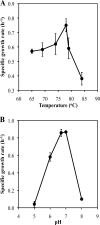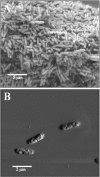Caldicellulosiruptor obsidiansis sp. nov., an anaerobic, extremely thermophilic, cellulolytic bacterium isolated from Obsidian Pool, Yellowstone National Park
- PMID: 20023107
- PMCID: PMC2820981
- DOI: 10.1128/AEM.01903-09
Caldicellulosiruptor obsidiansis sp. nov., an anaerobic, extremely thermophilic, cellulolytic bacterium isolated from Obsidian Pool, Yellowstone National Park
Abstract
A novel, obligately anaerobic, extremely thermophilic, cellulolytic bacterium, designated OB47(T), was isolated from Obsidian Pool, Yellowstone National Park, WY. The isolate was a nonmotile, non-spore-forming, Gram-positive rod approximately 2 microm long by 0.2 microm wide and grew at temperatures between 55 and 85 degrees C, with the optimum at 78 degrees C. The pH range for growth was 6.0 to 8.0, with values of near 7.0 being optimal. Growth on cellobiose produced the fastest specific growth rate at 0.75 h(-1). The organism also displayed fermentative growth on glucose, maltose, arabinose, fructose, starch, lactose, mannose, sucrose, galactose, xylose, arabinogalactan, Avicel, xylan, filter paper, processed cardboard, pectin, dilute acid-pretreated switchgrass, and Populus. OB47(T) was unable to grow on mannitol, fucose, lignin, Gelrite, acetate, glycerol, ribose, sorbitol, carboxymethylcellulose, and casein. Yeast extract stimulated growth, and thiosulfate, sulfate, nitrate, and sulfur were not reduced. Fermentation end products were mainly acetate, H2, and CO2, although lactate and ethanol were produced in 5-liter batch fermentations. The G+C content of the DNA was 35 mol%, and sequence analysis of the small subunit rRNA gene placed OB47(T) within the genus Caldicellulosiruptor. Based on its phylogenetic and phenotypic properties, the isolate is proposed to be designated Caldicellulosiruptor obsidiansis sp. nov. and OB47 is the type strain (ATCC BAA-2073).
Figures





Similar articles
-
Thermosinus carboxydivorans gen. nov., sp. nov., a new anaerobic, thermophilic, carbon-monoxide-oxidizing, hydrogenogenic bacterium from a hot pool of Yellowstone National Park.Int J Syst Evol Microbiol. 2004 Nov;54(Pt 6):2353-2359. doi: 10.1099/ijs.0.63186-0. Int J Syst Evol Microbiol. 2004. PMID: 15545483
-
Caloramator australicus sp. nov., a thermophilic, anaerobic bacterium from the Great Artesian Basin of Australia.Int J Syst Evol Microbiol. 2009 Jan;59(Pt 1):95-101. doi: 10.1099/ijs.0.000802-0. Int J Syst Evol Microbiol. 2009. PMID: 19126731
-
Caloramator boliviensis sp. nov., a thermophilic, ethanol-producing bacterium isolated from a hot spring.Int J Syst Evol Microbiol. 2012 Jul;62(Pt 7):1679-1686. doi: 10.1099/ijs.0.032664-0. Epub 2011 Sep 9. Int J Syst Evol Microbiol. 2012. PMID: 21908677
-
Description of Caldanaerobius fijiensis gen. nov., sp. nov., an inulin-degrading, ethanol-producing, thermophilic bacterium from a Fijian hot spring sediment, and reclassification of Thermoanaerobacterium polysaccharolyticum and Thermoanaerobacterium zeae as Caldanaerobius polysaccharolyticus comb. nov. and Caldanaerobius zeae comb. nov.Int J Syst Evol Microbiol. 2008 Mar;58(Pt 3):666-70. doi: 10.1099/ijs.0.65329-0. Int J Syst Evol Microbiol. 2008. PMID: 18319475
-
Biohydrogen Production by the Thermophilic Bacterium Caldicellulosiruptor saccharolyticus: Current Status and Perspectives.Life (Basel). 2013 Jan 17;3(1):52-85. doi: 10.3390/life3010052. Life (Basel). 2013. PMID: 25371332 Free PMC article. Review.
Cited by
-
Caldicellulosiruptor core and pangenomes reveal determinants for noncellulosomal thermophilic deconstruction of plant biomass.J Bacteriol. 2012 Aug;194(15):4015-28. doi: 10.1128/JB.00266-12. Epub 2012 May 25. J Bacteriol. 2012. PMID: 22636774 Free PMC article.
-
Microbial diversity in Los Azufres geothermal field (Michoacán, Mexico) and isolation of representative sulfate and sulfur reducers.Extremophiles. 2014 Mar;18(2):385-98. doi: 10.1007/s00792-013-0624-7. Epub 2014 Jan 21. Extremophiles. 2014. PMID: 24446065
-
Pyrosequencing reveals high-temperature cellulolytic microbial consortia in Great Boiling Spring after in situ lignocellulose enrichment.PLoS One. 2013;8(3):e59927. doi: 10.1371/journal.pone.0059927. Epub 2013 Mar 29. PLoS One. 2013. PMID: 23555835 Free PMC article.
-
Insights into plant biomass conversion from the genome of the anaerobic thermophilic bacterium Caldicellulosiruptor bescii DSM 6725.Nucleic Acids Res. 2011 Apr;39(8):3240-54. doi: 10.1093/nar/gkq1281. Epub 2011 Jan 11. Nucleic Acids Res. 2011. PMID: 21227922 Free PMC article.
-
Integrating CUREs in Ongoing Research: Undergraduates as Active Participants in the Discovery of Biodegrading Thermophiles.J Microbiol Biol Educ. 2021 Jun 30;22(2):e00102-21. doi: 10.1128/jmbe.00102-21. eCollection 2021 Fall. J Microbiol Biol Educ. 2021. PMID: 34594470 Free PMC article.
References
-
- Altschul, S. F., W. Gish, W. Miller, E. W. Myers, and D. J. Lipman. 1990. Basic local alignment search tool. J. Mol. Biol. 215:403-410. - PubMed
-
- Bradford, M. M. 1976. A rapid and sensitive method for the quantitation of microgram quantities of protein utilizing the principle of protein-dye binding. Anal. Biochem. 72:248-254. - PubMed
-
- Bredholt, S., J. Sonne-Hansen, P. Nielsen, I. M. Mathrani, and B. K. Ahring. 1999. Caldicellulosiruptor kristjanssonii sp. nov., a cellulolytic, extremely thermophilic, anaerobic bacterium. Int. J. Syst. Bacteriol. 49:991-996. - PubMed
-
- Ding, S. Y., Q. Xu, M. Crowley, Y. Zeng, M. Nimlos, R. Lamed, E. A. Bayer, and M. E. Himmel. 2008. A biophysical perspective on the cellulosome: new opportunities for biomass conversion. Curr. Opin. Biotechnol. 19:218-227. - PubMed
-
- Doktycz, M. J., C. J. Sullivan, P. R. Hoyt, D. A. Pelletier, S. Wu, and D. P. Allison. 2003. AFM imaging of bacteria in liquid media immobilized on gelatin coated mica surfaces. Ultramicroscopy 97:209-216. - PubMed
Publication types
MeSH terms
Substances
Associated data
- Actions
LinkOut - more resources
Full Text Sources
Other Literature Sources
Molecular Biology Databases

